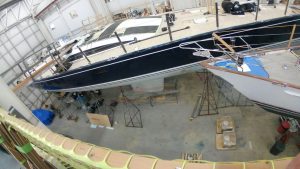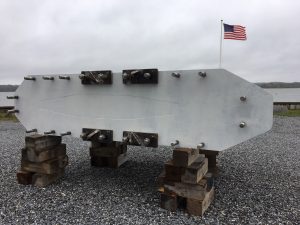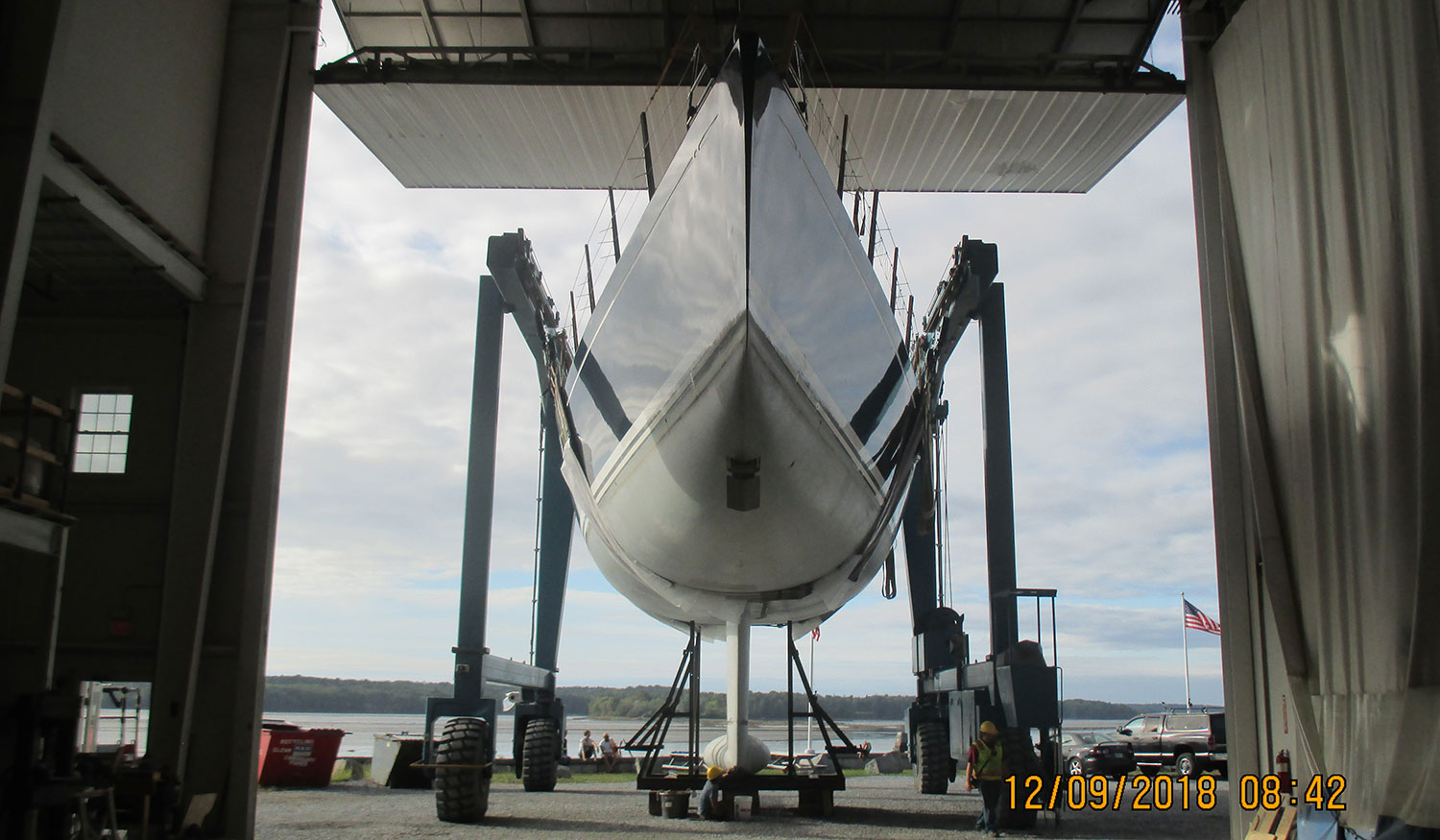It’s just another day for Lance Buchanan. The project manager has a list of 247 things to do, including removing a 33-ton keel from a 100-foot Nautor Swan.
“Obviously, you don’t just grab a wrench and unbolt the thing,” quipped the Alaskan-born Lyman-Morse project manager, who has a biology degree from the University of Alaska, and got into boat building 20 years ago when he graduated from The Landing School in Arundel, Maine. “When you are dealing with a keel this big, each step is a complex operation.”
 Buchanan and the Lyman-Morse team manage the keel removal, and the hundreds of other tasks in refitting this German Frers-designed Nautor racing and cruising sloop, from their offices in Building 11. This shop is the largest Lyman-Morse boatshed, located near the public landing in Thomaston, Maine. And the project managers’ offices are on the second and third floor of this commercial space that is about half the size of an average Home Depot, only taller.
Buchanan and the Lyman-Morse team manage the keel removal, and the hundreds of other tasks in refitting this German Frers-designed Nautor racing and cruising sloop, from their offices in Building 11. This shop is the largest Lyman-Morse boatshed, located near the public landing in Thomaston, Maine. And the project managers’ offices are on the second and third floor of this commercial space that is about half the size of an average Home Depot, only taller.
The project managers spend their hectic days orchestrating the flow of problems and progress that float up from the shop floor below, with the emails, questions and phone calls that flow down from the Nautor Swan’s professional skipper. Everyone is neck-deep in repairs, refits, and upgrades that are part of a much-needed reboot of this classic 100-footer.
Just One More 33-Ton Thing To Do
 Since September, when the Swan 100 arrived in Thomaston, the Lyman-Morse team of carpenters, mechanics, electricians, and painters have been methodically beavering away at a work order packed with invasive procedures, like prepping for detaching the 33-ton keel for inspection. (Lyman-Morse is a Swan Certified Service Center. Part of that benefit is sending a guy each year to Finland for training.)
Since September, when the Swan 100 arrived in Thomaston, the Lyman-Morse team of carpenters, mechanics, electricians, and painters have been methodically beavering away at a work order packed with invasive procedures, like prepping for detaching the 33-ton keel for inspection. (Lyman-Morse is a Swan Certified Service Center. Part of that benefit is sending a guy each year to Finland for training.)
“On this boat, nothing is simple. Everything is a story,” said Buchanan.
So let’s take you through how the Lyman-Morse team removed a keel — about the size and weight of a loaded cement truck — from a boat that’s essentially a floating three-bedroom condominium.
A Big Job with a Big Keel
 Getting a keel off of a Swan 100 for servicing is not something you do every day. Modern fin keels are not built into hulls; they are bolted on. So, the removal process starts by accessing these bolts. And that means the Lyman-Morse crew must spend about two weeks pulling out the engine, generator, battery banks, and most of the cabin sole in the main salon to access the twenty two, 52-millimeter diameter keel-attachment bolts.
Getting a keel off of a Swan 100 for servicing is not something you do every day. Modern fin keels are not built into hulls; they are bolted on. So, the removal process starts by accessing these bolts. And that means the Lyman-Morse crew must spend about two weeks pulling out the engine, generator, battery banks, and most of the cabin sole in the main salon to access the twenty two, 52-millimeter diameter keel-attachment bolts.
These roughly 2-inch, threaded fittings extend about 6 inches out of the top of the keel, right where it attaches to the boat’s hull. These half foot-long keel bolts are engineered to just pass through the bottom of the hull and be long enough so the massive 4-inch wide nuts, about the diameter of a compact disk and as thick as a fired brick, can thread on from inside the boat.
But in order to access those vertical keel bolts safely, our crew must first engineer and then fabricate a metal cradle that will support the keel fin and ballast bulb to keep it oriented exactly vertically when the hull is lifted away.
Rock the Boat
 Let us explain: Just like changing a tire, but off a giant earth mover, a Lyman-Morse mechanic armed with a powerful torque-multiplying wrench that allows a human to exert the 1600 foot pounds of torque necessary to break each nut free works each nut loose.
Let us explain: Just like changing a tire, but off a giant earth mover, a Lyman-Morse mechanic armed with a powerful torque-multiplying wrench that allows a human to exert the 1600 foot pounds of torque necessary to break each nut free works each nut loose.
Once all the nuts have been removed and the keel cradle’s protective scaffolding is ready around the outside of the Swan 100’s keel, the vessel is straddled by the Travelift to essentially “shake the keel loose”.
But merely removing those bulky fittings is not enough to free the keel. For that, the Lyman-Morse team must carefully impart a back-and-forth motion on the boat. You got it: They rock the boat. With the Travelift, the team starts slowly lifting the bow of the vessel just a few inches. The idea is to get a sliver of daylight to peek in from between the bottom of the keel and the support cradle. That tiny space is all that gravity needs to pull down the front of the keel, and gently stress the attachment points between it and the hull. Once that full force on the keel fittings is felt by the vessel, the bow is gently lowered, and the front portion of the keel is reset back into the cradle.
 Then, it’s the stern’s turn to be raised a few inches to loosen that glue joint. Once again, when the full force of gravity is exerted, the stern is lowered, the keel is reset in its cradle, and then the bow is re-raised for yet more keel attachment stressing.
Then, it’s the stern’s turn to be raised a few inches to loosen that glue joint. Once again, when the full force of gravity is exerted, the stern is lowered, the keel is reset in its cradle, and then the bow is re-raised for yet more keel attachment stressing.
This up-and-down stressing cycle is then repeated slowly, over the course of about two hours. The goal is to gently rock the Swan 100, in a teeter-totter motion, to sever the component seals that bond the keel to the hull.
“We’re looking for small puffs of smoke from the glue joints cracking,” said Buchanan. “That means the keel is starting to move.”
Inch by inch the hull is lifted off of the keel bolts until the keel sits perfectly vertical in its support cradle. The keel bolts are then cleaned and inspected using penetrant dyes. (That critical process is its own story, that we will dig into down the road.)
When asked how he and the other Lyman-Morse project managers juggle all these details and still find time for other work — and maybe even a day off — Buchanan responded, “I enjoy this kind of refit work. These kinds of details really force me to compartmentalize.”






